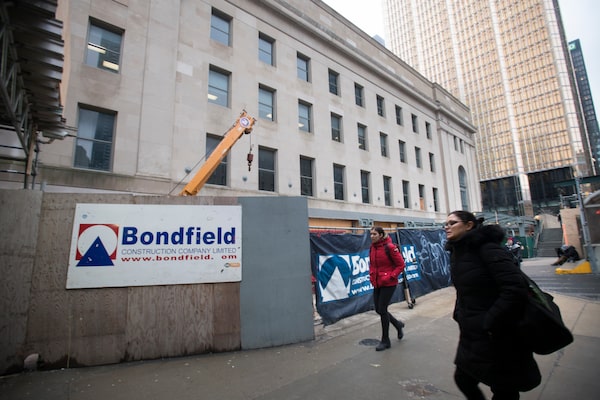
Construction hoarding outside Union Station bearing the name of Bondfield Construction on Jan. 14 2020.Fred Lum/The Globe and Mail
The Canadian banks that financed the troubled redevelopment of Toronto’s St. Michael’s Hospital are suing the hospital, as well as the provincial agency in charge of the awarding of the project, alleging they failed to keep the procurement from becoming “tainted and compromised.”
The syndicate of lenders, led by the Bank of Montreal, says it is out $230-million it advanced to Bondfield Construction Co. Ltd., the contractor selected for the project. Bondfield had been one of Ontario’s largest public-sector contractors until it collapsed in 2019 – a messy insolvency process that has unearthed allegations of fraud and bid-rigging.
The lawsuit raises more questions about how much taxpayers will ultimately pay for the long-delayed $300-million hospital project, which is at least five years behind schedule. St. Michael’s new 17-storey patient care centre, though partially occupied, is still under construction. That work started in 2015.
One of the defendants is Infrastructure Ontario, the provincial agency that oversees the awarding of all contracts for major public-sector building projects, such as hospitals, light rail transit and stadiums. The agency uses a model of financing known as public-private partnerships, or P3s. Under this system, builders are required to finance projects through private-sector loans, often from banks, and are only paid in public dollars when they reach certain milestones.
Infrastructure Ontario has said the model protects taxpayers, and that no public dollars for the St. Michael’s project will be handed over until it advances. The new lawsuit by the banks, however, will test just how strong that model is – and whether alleged impropriety by a former high-ranking executive at St. Michael’s will expose the public to major liabilities.
After Bondfield sought bankruptcy protection, the court-appointed monitor, Ernst & Young Inc., discovered hard copy e-mails that showed an insider at St. Michael’s had been advising Bondfield’s then president, John Aquino, on how to bid on the project in 2014.
E&Y later determined that insider was Vas Georgiou, St. Michael’s chief administrative officer during the procurement, and the hospital official in charge of the redevelopment. As investigators dug deeper, they learned Mr. Aquino had supplied Mr. Georgiou with a secret BlackBerry and his own bondfield.com e-mail address that the two men used to communicate throughout the procurement.
One of Bondfield’s largest creditors, Zurich Insurance Co. Ltd., sued the hospital, as well as Mr. Georgiou and Mr. Aquino. Zurich, which issued surety bonds on the project and was on the hook for its completion, alleged the process has been corrupted and asked the courts to rescind the bonds. That case is still proceeding in the courts.
But as part of its lawsuit, Zurich says it unearthed evidence that shows Mr. Georgiou intervened on behalf of Bondfield at two key stages of the bidding process: helping the company land on the short list of preferred bidders, and advocating for Bondfield when it received a low and near-disqualifying score for its final design submission. Mr. Georgiou has denied any wrongdoing.
The banks are now relying on that evidence to demand payment for the $230-million the syndicate advanced to Bondfield. They say Infrastructure Ontario and St. Michael’s had a duty to Bondfield’s lenders to ensure the procurement was conducted without undue influence.
“Collusion and improper communication did take place between Georgiou and Aquino throughout the procurement process. As a result, the procurement process was tainted and compromised,” the banks allege.
Mr. Aquino did not respond to a request for comment.
In addition to BMO, the other lenders are Toronto-Dominion Bank, National Bank of Canada and Desjardins Group. In an e-mailed statement on behalf of the lenders, a BMO spokesperson called it an “unfortunate situation,” explaining that the banks “would have preferred to resolve this matter out of court.”
The situation is particularly sensitive for BMO, which has deep ties to St. Michael’s. William Downe, BMO’s former chief executive officer, chaired the board of St. Michael’s from 2006 to 2009, but stepped down long before the redevelopment contract was awarded. Frank Techar, a former BMO chief operating officer, chaired the committee of the board that kept tabs on the procurement.
Both men have since retired from the bank, but serve on the board of the St. Michael’s Foundation, the fundraising arm of the hospital.
The banks’ statement of claim also takes aim at the findings of internal investigations launched by the hospital and Infrastructure Ontario. In 2015, The Globe and Mail published a series of stories about the close commercial ties between Mr. Aquino and Mr. Georgiou – connections neither man disclosed before the bidding process.
In response, a special committee of Infrastructure Ontario’s board released a 2016 report that concluded the “procurement was not compromised.”
The banks allege the assurances they were given about the sanctity of the process were “false, inaccurate and misleading and are actionable as misrepresentations.”
In their claim, the banks demand full access to all communications about the procurement – including “meeting notes, reports, evaluations, emails, text messages” – from Unity Health Toronto, the network of Catholic hospitals that includes St. Michael’s, and Infrastructure Ontario.
In an e-mailed statement, Infrastructure Ontario did not address the specific allegations contained in the banks’ claim. But a spokesperson for the agency said it had been working closely with the hospital “in every way possible to mitigate the challenges of an insolvent general contractor.”
Jennifer Stranges, a spokesperson for Unity Health, said in an e-mail that the completed portions of the patient care tower have “provided much needed critical care capacity for COVID-19 patients during the height of the pandemic.”
The entire project, which includes the new tower, as well as an expanded emergency department and a fully renovated intensive care unit, is scheduled to be completed in 2025, she said.
Your time is valuable. Have the Top Business Headlines newsletter conveniently delivered to your inbox in the morning or evening. Sign up today.
 Greg McArthur
Greg McArthur Irene Galea
Irene Galea